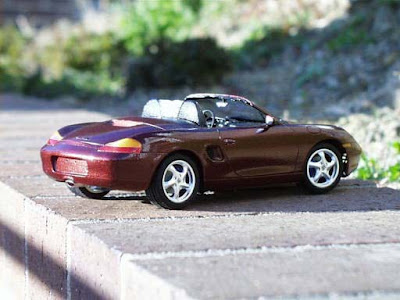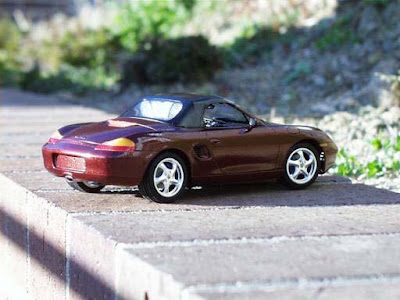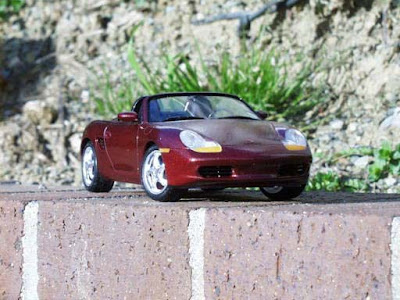
(More photos of the final model are bottom of this page.)
Review was made by Trygve Isaacson.
Since I have been eagerly awaited delivery of my red Boxster Arena, I thought I would try a model of the building. I have never seen a pattern in my life, so I wondered if it would all come right. It has. The following are some pointers and advice from the building, with photographs of the process and the final outcome. Regardless of whether you are waiting for your Boxster to be built, or already have, I can definitely recommend creating your own model, which has your colors. It is not very difficult, and it's fun. Let paint for drying time between work sessions; You can probably project in a handful of 1 - or 2 hours.
The kit and supplies
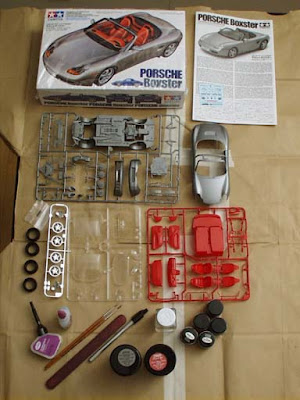
I had seen a reference to the Tamiya Model Kit (# 24187, 1 / 24 scale, 7 cm long) on the Boxster Board, so I www.tamiya.com examined, and they even had a dealer list, which Hobby Shop five minutes from my house. I listened to and noted that, in order for me and you again in a few weeks. When it came, I had no idea what would be necessary to build, but the people in the hobby shop were so friendly to fix me with the necessary project returns. The parts in the model kit actually has specific Tamiya paint figures, but you can find correspondences.
The model kit was 30 dollars. Further information: Testors 3 ounces. Spray paint cans (FS36251 Navy aggressor Gray (primer), 1247 Gloss Black, 2905 Burgundy Red Metallic, which I hope, in the vicinity of Porsche Arena Red Metallic), Testors 1 / 4 ounces. Brush on glossy enamel colors (1145 white license plates, 1147 black for many things, 1111 dark blue for chassis), Testors 1 / 2 ounces. Melting custom brush on colors (silver chrome FS17178 for chrome pipes, 1780 steel for various metallic objects, flat black for FS37078 Cabriopersenning and other objects, Turn Signal in 2723 and 2724 Amber Stop Red Light for brake lights and turn signal), 1 / 2 ounces. Cyanoactrylate (uh, Super Glue), Testors 1 oz. Clear Parts Cement (special invisible adhesive for clear plastic parts), paint thinner, nail file / sandpaper x-acto knives, small wire cutters (to cut the parts from the plastic model forms), tweezers for holding by hand into small pieces painting, kids brush (sizes 2, 0, and 5 / 0). Total cost of the kit and all the supplies to about 65 dollars.
Paint primed
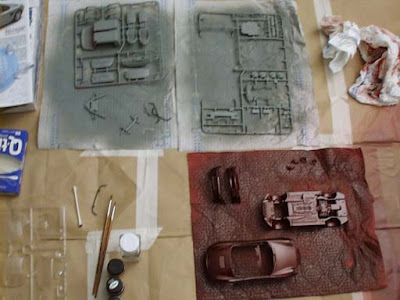
There are essentially three plastic parts with bars that you cut (01 mostly parts to be painted and the other parts usually painted on the outside, and with a clear plastic to left alone or spot-varnished), as well as the body, chrome parts and tires.
The first thing to do is to spray a coat gray primer on the parts, which are painted. Lesson learned: Let it dry! I have the bug starts to paint and paste some of the suspension pieces from the primer was completely dry. If you're going to glue a piece of paint or a paint primer, let it dry overnight. If additional layers of the same color to a piece, to do so may be within 3 hours after the last coat.
Color for the body pack (chassis, body, bumpers, exterior mirrors, and engine intake vents), apply several layers of the desired color. My mistake was to worry about the complete coverage on the first layer, a first in the thick mantle and some chunkiness. It is better to multiple thin layers, repeat until it is completely covered and solid. Be patient.
Once you've got the most important sections of primed and painted body color parts in your car is outside color, and it's all dry, you are ready to start cutting pieces out of the grid, from the grinding, painting and gluing.
Painting the Undercarriage
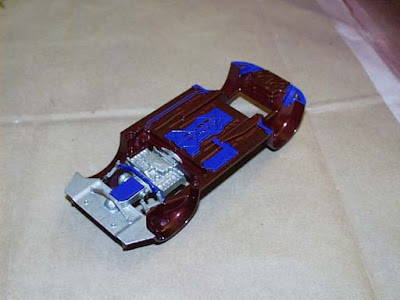
I do not know why they say blue for the chassis accents, but I follow the instructions. Is it really under blue? The engine and the rear deck are gray metal.
Assembling the Exhaust
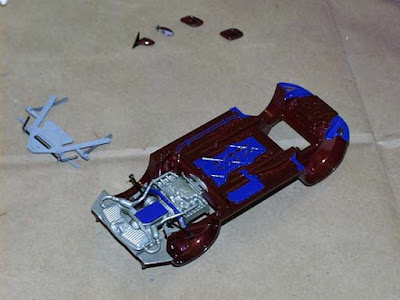
The exhaust assembly used metal gray color for the pipes with chrome accents at the terminals. For the exhaust muffler, the color of paint instructions for something that I did not think would be until I tried it: Mix paint with chrome flasher Bernstein. The result is a somewhat tarnished chrome color. It works well for the muffler, which definitely is not too bright chrome. The stem is a separate piece from the parts chrome grille.
Construction of the Suspension Bridge
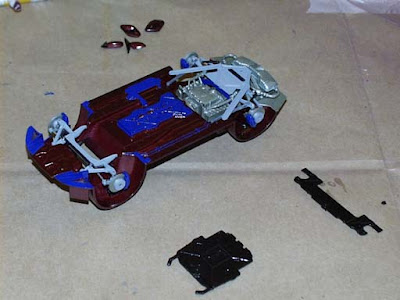
That is, if you add some complex assembly and bonding. Again, I recommend that you use the paint plenty of time to dry before you stick pieces together. Otherwise, you can use glue with a soft surface, which are not. Patience!
Follow the instructions in regard to certain items that you are not stuck together. Most important is the front suspension, which allows the wheels to turn, because they are not totally glued. You are advised to unplug from between the wheel wells and cross bars, but pivotable.
The rear suspension is the most difficult to stick. Once assembled, the entire assembly is the one on the engine and exhaust, in a large meeting, attaching at least eight points stick. It is difficult, they are all capable of quickly before the glue. I had two points glue that is not quite true, but at the end it is not really significant.
The rotors and calipers are glued to the suspension, but in each rotor is a rubber seal that is not glued. The wheels will attach using this seal, the remaining rollable.
Finishing the lower part of the body

With every piece of suspension in effect, the two pieces meet, which get painted radiator grille, and wheels and tires slide Customs This is a little nerve racking, because you have to pretty hard, and it seems like the suspension will Snap In the pressure. Actually, I had another Glue the rotors before that I was not completely dry when I glued.
Finishing the interior and exterior doors
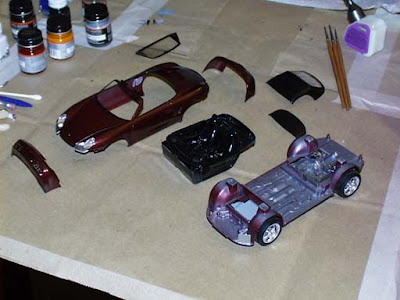
Once you remove the non-interior pieces from the grid, you can spray all of the interior pieces still on the grid. My interior is black, based on the work easier, I could just spray the whole thing black. Interior with other colors you need to spray the inside of color, and then hand paint on many small black spots in the cockpit.
This is also a good time to paint the hand from top to bottom tonneau pieces and the upper piece until soft. I did not bother painting the hard top, because I am not always. It is also a good time to the various black trim parts as the windshield, brakes and engine intake grilles, and the bumpers and fender flares.
Finally, there's still a fair amount of outside work to be done. The chrome and glass parts like headlights, taillights, windshield, rear-view mirror, exterior mirrors, etc. must be painted and / or glued.
For fear of a permanent error, I chose not to the interior section adhesive or upper body to the lower part of the body. The fit is tight enough to simply good.
For the rear deck Boxster logo, I only have a little black paint on a piece of paper and touched them in the light, the lettering. I did not want to screw it up by brushing up and get it in between the letters.
The stickers suck. I had little success getting them to stop. I have two of the wheel Cap stickers, and participated in a small adhesive for the hood badge stickers and sticker brake light, which is also a little too big.
I left the soft top unglued, so that it lifts from the top down. It is not quite fit flush against the top of the windshield, but it could, if I had decided to permanently glue at the top of the soft.
The final product!
Here are some photos I have a Olympus D-500L digital camera. Click on an image to the photo in full size. (Actually, they are half the size. The originals were 1024x768.)

